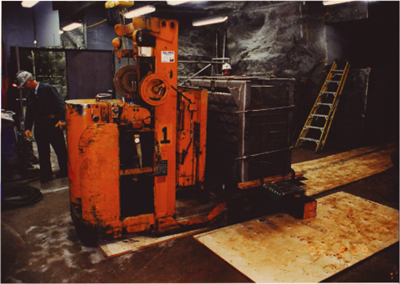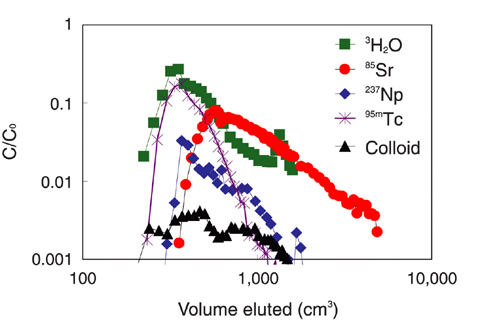
Fig.5-17 Forklift transporting granite block containing natural fracture, quarried at a depth of 240m

Fig.5-18 Radionuclide and colloid elution profiles, normalized to the injection concentrations
In the Japanese program, high-level radioactive waste (HLW) is vitrified, encapsulated in a metal container called overpack, surrounded by engineered buffer material, and emplaced in a repository constructed in stable rocks at a depth of 300m or greater. In safety assessments of this disposal method, the possibility that long-lived radionuclides may be leached from the wastes and may subsequently be transported through surrounding rock masses must be considered. It is therefore necessary to understand the transport of radionuclides through water-bearing fractures in rocks surrounding the repository. For this purpose, in situ radionuclide migration experiments were performed at the 240-m level in Atomic Energy of Canada Ltd.'s (AECL) Underground Research Laboratory under a five-year cooperative research program with AECL.
Two granite blocks, each with a volume of ~ 1m3 and containing a single fracture were excavated from a water-bearing fracture zone with special care to minimize changes in the geochemical conditions (Fig.5-17). Migration experiments were performed by injecting 3H, 85Sr, 95mTc, 237Np, 238Pu, and synthetic colloids, followed by groundwater injection.
As predicted from earlier sorption studies, radionuclide transport by groundwater through the fractures was retarded by sorption on rock-forming minerals and was element-specific (Fig.5-18). Strontium exhibited weak reversible sorption. Plutonium was strongly sorbed near the inlet of the fractures, as shown by post-experiment radiometric analysis of the fracture surfaces. The elution peaks for 95mTc and 237Np suggested that fractions of these radionuclides were transported without retardation and that the remainder was retained within the fractures. Transport of 95mTc and 237Np can be explained by a kinetically slow redox reaction. The redox kinetics is often affected by microbial activities.
Colloid concentrations in the eluted groundwater were low, again as expected, and may have been controlled by sedimentation and diffusion into stagnant zones.
We demonstrated the retardation of radionuclide migration deep underground and gave possible mechanisms. Further investigations are needed to determine if the postulated mechanisms are valid over long periods of time, to be confident of the safety of the disposal. Of particular interest is whether colloids enhance or limit radionuclide migration in fractures.